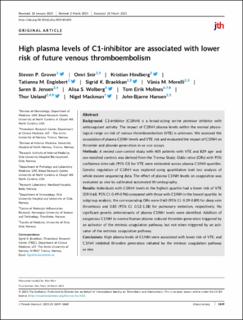| dc.contributor.author | Grover, Steven P. | |
| dc.contributor.author | Snir, Omri | |
| dc.contributor.author | Hindberg, Kristian Dalsbø | |
| dc.contributor.author | Englebert, Tatianna M. | |
| dc.contributor.author | Brækkan, Sigrid Kufaas | |
| dc.contributor.author | Morelli, Vania Maris | |
| dc.contributor.author | Jensen, Søren Beck | |
| dc.contributor.author | Wolberg, Alisa S. | |
| dc.contributor.author | Mollnes, Tom Eirik | |
| dc.contributor.author | Ueland, Thor | |
| dc.contributor.author | Mackman, Nigel | |
| dc.contributor.author | Hansen, John Bjarne | |
| dc.date.accessioned | 2023-07-18T14:15:22Z | |
| dc.date.available | 2023-07-18T14:15:22Z | |
| dc.date.created | 2023-05-26T13:04:20Z | |
| dc.date.issued | 2023 | |
| dc.identifier.citation | Journal of Thrombosis and Haemostasis. 2023, . | en_US |
| dc.identifier.issn | 1538-7933 | |
| dc.identifier.uri | https://hdl.handle.net/11250/3079722 | |
| dc.description.abstract | Background
C1-inhibitor (C1INH) is a broad-acting serine protease inhibitor with anticoagulant activity. The impact of C1INH plasma levels within the normal physiological range on risk of venous thromboembolism (VTE) is unknown. We assessed the association of plasma C1INH levels and VTE risk and evaluated the impact of C1INH on thrombin and plasmin generation in ex vivo assays.
Methods
A nested case-control study with 405 patients with VTE and 829 age- and sex-matched controls was derived from the Tromsø Study. Odds ratios (ORs) with 95% confidence intervals (95% CI) for VTE were estimated across plasma C1INH quartiles. Genetic regulation of C1INH was explored using quantitative trait loci analysis of whole exome sequencing data. The effect of plasma C1INH levels on coagulation was evaluated ex vivo by calibrated automated thrombography.
Results
Individuals with C1INH levels in the highest quartile had a lower risk of VTE (OR 0.68, 95% CI: 0.49-0.96) compared with those with C1INH in the lowest quartile. In subgroup analysis, the corresponding ORs were 0.60 (95% CI: 0.39-0.89) for deep vein thrombosis and 0.85 (95% CI: 0.52-1.38) for pulmonary embolism, respectively. No significant genetic determinants of plasma C1INH levels were identified. Addition of exogenous C1INH to normal human plasma reduced thrombin generation triggered by an activator of the intrinsic coagulation pathway, but not when triggered by an activator of the extrinsic coagulation pathway.
Conclusions
High plasma levels of C1INH were associated with lower risk of VTE, and C1INH inhibited thrombin generation initiated by the intrinsic coagulation pathway ex vivo. | en_US |
| dc.language.iso | eng | en_US |
| dc.publisher | Elsevier | en_US |
| dc.rights | Navngivelse 4.0 Internasjonal | * |
| dc.rights.uri | http://creativecommons.org/licenses/by/4.0/deed.no | * |
| dc.title | High plasma levels of C1-inhibitor are associated with lower risk of future venous thromboembolism | en_US |
| dc.title.alternative | High plasma levels of C1-inhibitor are associated with lower risk of future venous thromboembolism | en_US |
| dc.type | Peer reviewed | en_US |
| dc.type | Journal article | en_US |
| dc.description.version | publishedVersion | en_US |
| dc.source.pagenumber | 0 | en_US |
| dc.source.journal | Journal of Thrombosis and Haemostasis | en_US |
| dc.identifier.doi | 10.1016/j.jtha.2023.03.024 | |
| dc.identifier.cristin | 2149579 | |
| cristin.ispublished | true | |
| cristin.fulltext | original | |
| cristin.qualitycode | 2 | |

